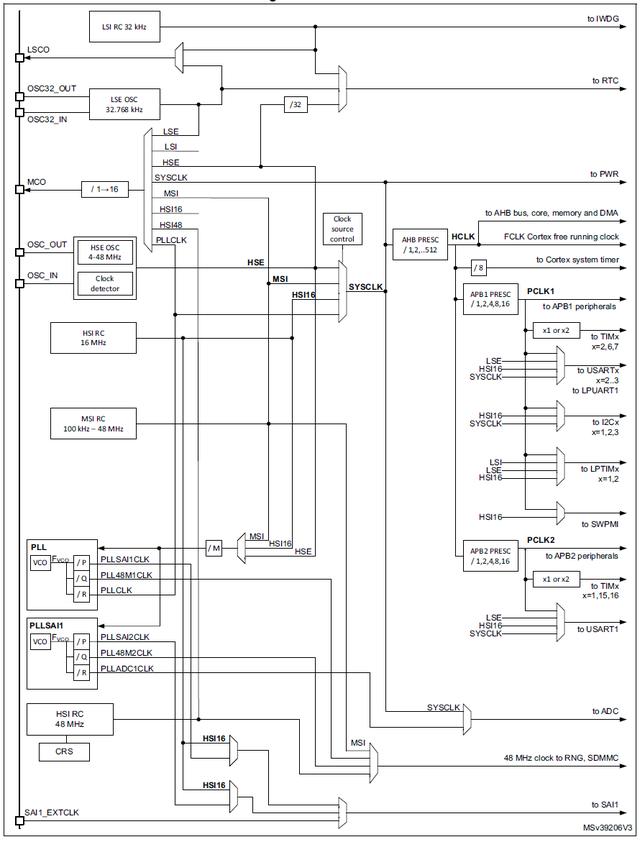stm32l151初始化时间(STM32L431时钟系统初始化示例)
STM32L431有4个时钟源可以作为系统时钟:
- HSE: 高速外部晶体或陶瓷谐振器, 4 MHz - 48 MHz
- HSI16: 高速内部RC振荡器, 16 MHz
- MSI: 多种频率可选的内部RC振荡器, 100KHz - 48MHz 之间共有12档频率可选
- PLL: 系统内部的PLL, 可以将HSE, HSI16, MSI作为输入时钟源, 设置倍频系数, 输出最高80MHz作为系统时钟
系统上电后, 默认MSI(4MHz)作为系统时钟, 但本文将使用HSE(24.576MHz的外部晶振)作为PLL的输入时钟源,使PLL产生73.728MHz作为系统时钟.
下图为STM32L431的时钟系统结构框图:

实现HSE作为PLL时钟源,并将PLL输出作为系统时钟的源程序如下:
typedef struct
{
__IO uint32_t CR; /*!< RCC clock control register, */
__IO uint32_t ICSCR; /*!< RCC Internal Clock Sources Calibration Register, */
__IO uint32_t CFGR; /*!< RCC clock configuration register, */
__IO uint32_t PLLCFGR; /*!< RCC System PLL configuration register, */
__IO uint32_t PLLSAI1CFGR; /*!< RCC PLL SAI1 Configuration Register, */
uint32_t RESERVED_0; /*!< Reserved, */
__IO uint32_t CIER; /*!< RCC Clock Interrupt Enable Register, */
__IO uint32_t CIFR; /*!< RCC Clock Interrupt Flag Register, */
__IO uint32_t CICR; /*!< RCC Clock Interrupt Clear Register, */
uint32_t RESERVED0; /*!< Reserved, */
__IO uint32_t AHB1RSTR; /*!< RCC AHB1 peripheral reset register, */
__IO uint32_t AHB2RSTR; /*!< RCC AHB2 peripheral reset register, */
__IO uint32_t AHB3RSTR; /*!< RCC AHB3 peripheral reset register, */
uint32_t RESERVED1; /*!< Reserved, */
__IO uint32_t APB1RSTR1; /*!< RCC APB1 macrocells resets Low Word, */
__IO uint32_t APB1RSTR2; /*!< RCC APB1 macrocells resets High Word, */
__IO uint32_t APB2RSTR; /*!< RCC APB2 macrocells resets, */
uint32_t RESERVED2; /*!< Reserved, */
__IO uint32_t AHB1ENR; /*!< RCC AHB1 peripheral clock enable register, */
__IO uint32_t AHB2ENR; /*!< RCC AHB2 peripheral clock enable register, */
__IO uint32_t AHB3ENR; /*!< RCC AHB3 peripheral clock enable register, */
uint32_t RESERVED3; /*!< Reserved, */
__IO uint32_t APB1ENR1; /*!< RCC APB1 macrocells clock enables Low Word, */
__IO uint32_t APB1ENR2; /*!< RCC APB1 macrocells clock enables High Word, */
__IO uint32_t APB2ENR; /*!< RCC APB2 macrocells clock enabled, */
uint32_t RESERVED4; /*!< Reserved, */
__IO uint32_t AHB1SMENR; /*!< RCC AHB1 macrocells clocks enables in sleep mode, */
__IO uint32_t AHB2SMENR; /*!< RCC AHB2 macrocells clock enables in sleep mode, */
__IO uint32_t AHB3SMENR; /*!< RCC AHB3 macrocells clock enables in sleep mode, */
uint32_t RESERVED5; /*!< Reserved, */
__IO uint32_t APB1SMENR1; /*!< RCC APB1 macrocells clock enables in sleep mode Low Word, */
__IO uint32_t APB1SMENR2; /*!< RCC APB1 macrocells clock enables in sleep mode High Word, */
__IO uint32_t APB2SMENR; /*!< RCC APB2 macrocells clock enabled in sleep mode, */
uint32_t RESERVED6; /*!< Reserved, */
__IO uint32_t CCIPR; /*!< RCC IPs Clocks Configuration Register, */
__IO uint32_t RESERVED7; /*!< Reserved, */
__IO uint32_t BDCR; /*!< RCC Vswitch Backup Domain Control Register, */
__IO uint32_t CSR; /*!< RCC clock control & status register, */
__IO uint32_t CRRCR; /*!< RCC Clock recovery RC register, */
__IO uint32_t CCIPR2; /*!< RCC Peripherals independent clock configuration register, */
} RCC_TypeDef;
#define PERIPH_BASE ((uint32_t)0x40000000)
#define AHB1PERIPH_BASE (PERIPH_BASE 0x00020000)
#define RCC_BASE (AHB1PERIPH_BASE 0x1000)
#define RCC ((RCC_TypeDef *) RCC_BASE)
#define RCC_CR_HSEON ((uint32_t)0x00010000)
#define RCC_CR_HSERDY ((uint32_t)0x00020000)
#define RCC_CR_PLLON ((uint32_t)0x01000000)
#define RCC_CR_PLLRDY ((uint32_t)0x02000000)
#define RCC_PLLCFGR_PLLSRC_HSE ((uint32_t)0x00000003)
#define RCC_PLLCFGR_PLLREN ((uint32_t)0x01000000)
#define RCC_CFGR_HPRE_DIV1 ((uint32_t)0x00000000)
#define RCC_CFGR_PPRE1_DIV4 ((uint32_t)0x00000500)
#define RCC_CFGR_PPRE2_DIV4 ((uint32_t)0x00002800)
#define RCC_CFGR_SW_PLL ((uint32_t)0x00000003)
#define RCC_CFGR_SWS ((uint32_t)0x0000000C)
#define RCC_CFGR_SWS_PLL ((uint32_t)0x0000000C)
/*
* 初始化STM32L431时钟系统
*
* 输入时钟: HSE(24.576MHz)
*
* PLL输出: 73.728MHz
*/
void RCC_Init(void)
{
/*****************************************
* 1. 启动HSE
******************************************/
// MSI = 4MHz, MSI时钟开
RCC->CR = 0x00000063;
// HSE时钟开
RCC->CR |= RCC_CR_HSEON;
// 等待HSE工作正常
for(;;)
{
if (RCC->CR & RCC_CR_HSERDY) break;
}
/*****************************************
* 2. 启动PLL
******************************************/
// 此寄存器设置了: PLLN = 12 , PLLM = 2 , PLLR = 2
RCC->PLLCFGR = 0x00000C10;
// 将HSE(24.576M)指定为PLL的时钟源, PLLSRC = 24.576MHz
RCC->PLLCFGR |= RCC_PLLCFGR_PLLSRC_HSE;
// fVCO = PLLSRC * (PLLN / PLLM) = 24.576M * (12 / 2) = 147.456M
// PLLCLK = fVCO / PLLR = fVCO / 2 = 73.728M
// PLL开
RCC->CR |= RCC_CR_PLLON;
// 等待PLL工作正常
for(;;)
{
if (RCC->CR & RCC_CR_PLLRDY) break;
}
// PLLCLK输出允许
RCC->PLLCFGR |= RCC_PLLCFGR_PLLREN;
/*****************************************
* 3. 分配各时钟频率
******************************************/
RCC->CFGR = 0;
// AHB -HCLK = SYSCLK / 1 = 73.728MHz
RCC->CFGR |= RCC_CFGR_HPRE_DIV1;
// APB1-PCLK1 = HCLK / 4 = 18.432MHz
RCC->CFGR |= RCC_CFGR_PPRE1_DIV4;
// APB2-PCLK2 = HCLK / 4 = 18.432MHz
RCC->CFGR |= RCC_CFGR_PPRE2_DIV4;
// 选择 PLLCLK(73.728MHz) 作为SYSCLK
RCC->CFGR |= RCC_CFGR_SW_PLL;
// 等待SYSCLK = PLLCLK选择成功
for(;;)
{
if ((RCC->CFGR & RCC_CFGR_SWS) == RCC_CFGR_SWS_PLL) break;
}
}
免责声明:本文仅代表文章作者的个人观点,与本站无关。其原创性、真实性以及文中陈述文字和内容未经本站证实,对本文以及其中全部或者部分内容文字的真实性、完整性和原创性本站不作任何保证或承诺,请读者仅作参考,并自行核实相关内容。文章投诉邮箱:anhduc.ph@yahoo.com






